In the aftermath of my mother’s death a few years ago, during the onset of the pandemic, I started sorting through old documents and came across a couple of small metal strongboxes. One was red, the other blue; both were locked, the keys on a chain in a larger storage container. It was clearly my father’s handiwork. Although he had died nearly a decade earlier, his meticulous archiving of every family artefact remained unexamined until there was no alternative.
Some papers were yellowed and thin, others were stiff like parchment. They included old letters written by his parents before World War II, a psychological assessment of my father’s mental health after his experiences during the war, the bill for the Rolls-Royce hire car from my parents’ wedding, the receipts from the Surfers Paradise motel where they stayed on their honeymoon, and even an inventory of the furniture made for them by my mother’s uncle. It felt like time travel.
The red strongbox contained an envelope with a bunch of thick papers. Inside was a legal document with a series of red stamps, typed on starchy paper, that seemed to link my grandfather to the estate of a man in New York. I couldn’t make head or tail of what it meant. Having worked as a journalist for 35 years, I thought I had pried every last secret from my father’s distant past. But we were in lockdown; there was plenty of time to work on this one.
A few months later – after endless combing of newspaper reports, shipping archives, academic monographs, midnight calls to American book dealers, collectors, and their children – I was a walking encyclopedia about a man who it seemed had done something, I didn’t yet quite know what, that shaped my family history.
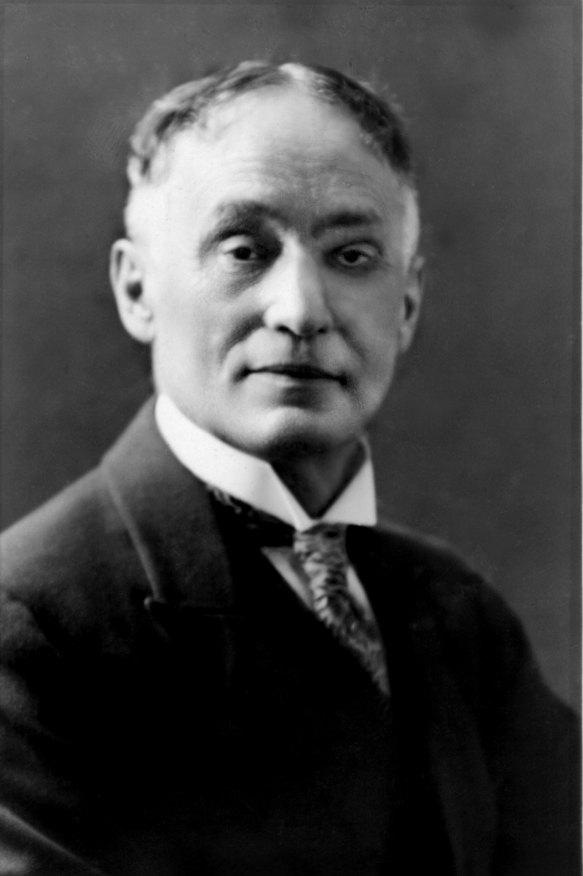
Gabriel Wells in New York, 1920sCredit: Mesrobian New York, Francis F. Dobocollection, courtesy Michael Dobo
His name was Gabriel Wells, an antiquarian book dealer in New York. A little over 100 years ago, Wells embarked on an audacious gambit that turned the rarefied world of book collecting on its head. He broke up a copy of a Gutenberg Bible into individual and small groups of leaves (two pages to a leaf) and sold them off. This was not just any bible. The Gutenberg Bible was the first substantial book in the Western world printed on a printing press. It was, and still is, the Holy Grail of rare books. Book lovers were “horrified”. It was sacrilegious, an act of bibliophilic vandalism.
The year was 1921. Wells was an established figure in the trade, with an office on Fifth Avenue and a reputation on both sides of the Atlantic – but in possession of a bible missing some 50 of its 640-odd leaves. The grandees and scholars of the bibliophile world were divided. Was Wells’ plan a desecration or a canny deal? For every frown of disapproval, there was a lick of the lips. Institutions lined up to acquire pages missing from their own Gutenberg Bibles. A cavalcade of collectors put up their hands for famous texts ranging from the Book of Genesis to the Ten Commandments, the Sermon on the Mount and the Book of Esther. Wells was offering them a who’s who of biblical icons.
Today, the antiquarian book trade is a relatively niche world, rarely breaking into the hectic media landscape. A century ago, especially in Manhattan, it was frequently in the news, often on the front page, where it served as a barometer of the financial boom. The Roaring Twenties ushered in the “Gatsby” era of fabulous wealth in America, and it triggered a feeding frenzy by tycoons to acquire items that would reflect their newfound status. They indulged their personal vanities by paying ridiculous prices for rare and historic books. Titans such as Henry Huntington, John Pierpont Morgan, and Pierre du Pont amassed huge fortunes in banking and finance, transport and industry. They had wealth and opportunity, and a lot of them wanted to build a library to signal their status in society.
Wells gave his enterprise the deluxe treatment. He packaged the leaves in a fancy leather folder, commissioned an essay that extolled their precious rarity – and marketed them as “Noble Fragments”. The essay preface began: “Reader, pause awhile for you look at maybe for the first time, upon an actual page of a Gutenberg Bible, the most precious piece of printing in the world”, and ended with a hyperbolic quote: “Not only is this the first Bible, but it is the first book ever printed. Let no Custom House official, or other man in or out of authority, see it without first reverently raising his hat. It is not possible for many men ever to touch or even look upon a page of a Gutenberg Bible.”

Advertisement by Gabriel Wells for the Noble Fragments of the Book of Revelation.Credit: (Columbia University Rare Book & Manuscript Library)
The Noble Fragments sold like hot cakes. This would not have surprised any serious bibliophile. The significance of the Gutenberg Bible cannot be overstated. Up until it was printed in 1455, books were handwritten, a slow and laborious process that limited production to a handful. The German inventor Johannes Gutenberg made the bible plentiful, and the technology allowed ordinary people to read and debate it, a challenge to the clergy and the wealthy, who were previously the only people who had access to books.
The watershed began in the town of Mainz in Germany around 1450, when three acquaintances decided to enter into a partnership. Over the next five years the trio —Gutenberg, with his financier, Johann Fust, and a printer, Peter Schöffer — collaborated to print 180 copies, in Latin, of what is now known as the Gutenberg Bible. In time, Gutenberg’s innovation would usher in cheap, mass printing and make reading accessible to everyone.
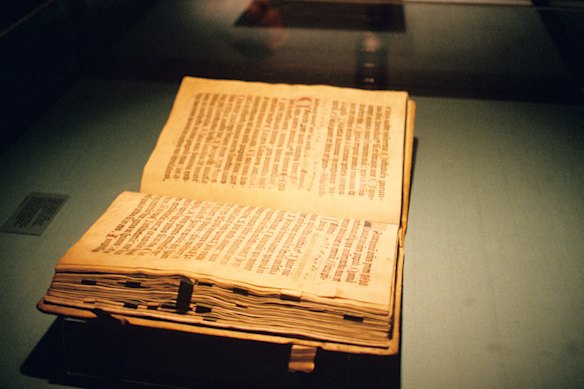
A Gutenberg Bible at the Mainz Museum, Germany.Credit: Alamy
The printing press was a foundation of the Renaissance, becoming an indispensable tool for the expression of free thought. Print was at the heart of the political and religious upheavals of the 16th century. It accelerated the spread of universities, enabled the creation of widespread education, book publishing, entertainment, and newspaper industries. The Gutenberg Bible opened the window to untold new audiences. It represents the democratisation of knowledge, a landmark in the advance of civilisation.
By the time Gabriel Wells purchased his copy, there were fewer than 50 of these bibles left in existence. Once he broke it up, the opportunity to claim ownership of a Gutenberg skyrocketed, even if it was not a whole bible. For just a fraction of the price of the whole book, collectors could now enjoy a piece of the Gutenberg mystique.
Up to that point, Gabriel Wells was a journeyman who had built a successful business, but it was far from stellar. He was born the first of 10 children – seven girls and three boys – in a small town just north of Budapest, Hungary, in 1862, to a family of prosperous Jewish wool merchants. As a young man, Wells had an adventurous streak and entrepreneurial flair, a combination that would become his calling card in life. Despite only a few years of formal education, he mastered eight foreign tongues.
After finishing school, he went to work for a town business and met a local girl and his parents looked forward to seeing a new generation of the family. Things didn’t go quite according to plan. The young man in a hurry got himself involved in a venture that landed him in debt and bankruptcy, a fact he hid from his wife and which soured the marriage. Wells left the country in haste to elude his creditors. Within two years, his wife applied for a divorce, no doubt prompted by the fact that her husband had, without telling her, emigrated to the United States.
He turned up in Boston in 1894, part of the great influx of migrants from eastern Europe who left their homelands to find a more prosperous life elsewhere. Though Wells was more likely driven by a desire to escape his financial and matrimonial problems, he arrived in the New World as poor as the rest of them, and barely able to communicate. Despite his mastery of so many languages, he had overlooked English, a strange lapse from someone with his sights set on America. Wells soon made his way to New York, where the newspapers reported the eye-watering sums that the new tycoons were spending on building libraries, and he latched onto the potential of trading in rare and antiquarian books.
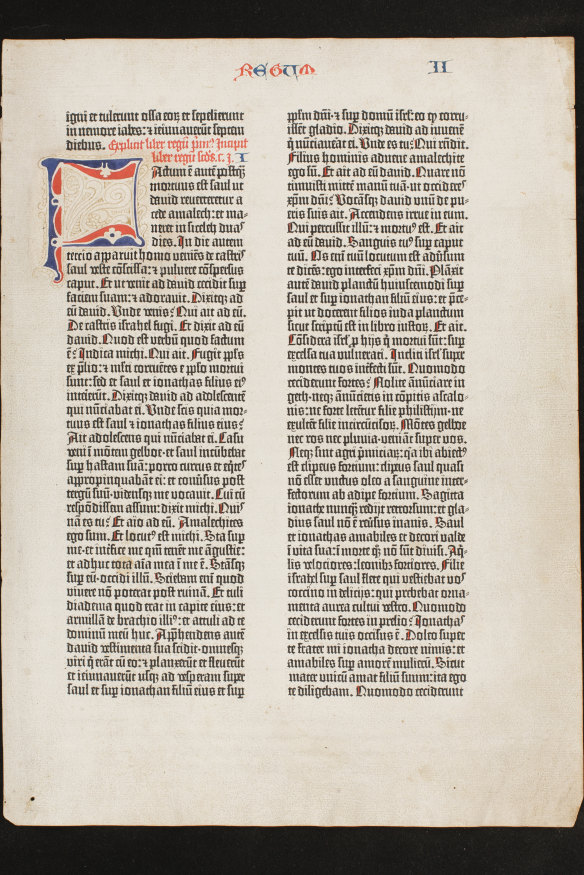
A Noble Fragment with the missing initial F replaced in facsimile on modern paper.Credit: Princeton University Library Special Collections
It would be more than a decade before he found the opportunity to snare a Gutenberg Bible. Wells bought it, under the radar, one of the last items at a Sotheby’s auction in London and decided to break it up, with the justification that he would offer libraries the chance to purchase leaves to fill in those missing from their own copies. Of the 45 copies known to exist at the time, only 22 were complete. But there was also a major windfall in the offing. Wealthy collectors vied with universities for these precious leaves. They were snapped up quickly and Wells realised a bigger profit by breaking up the bible than other dealers made by trading theirs intact.
The venture received sustained publicity, his bank balance swelled, and so did his reputation, lifting him from the second tier of dealers into the big league. Wells became a major dealer and a very wealthy man. But he could not have imagined the reverberations that his gambit would trigger around the world. It unleashed fanatical passions among book lovers, whose pursuit of the individual pages of the bible endowed them with their own unique identities. Yet Wells forged something more. I know because his decision, and the chain of events that followed, changed the destiny of a father and son battered by the Holocaust.
My father, Ivan, grew up in a small provincial Hungarian town called Gyongyos, about 100 kilometres from the capital Budapest. Before the war, his father Pali owned a delicatessen, and his mother Sara helped out behind the counter. When the Nazis occupied Hungary in 1944, Ivan was 14. First his father was sent away to Mauthausen, then Ivan and his mother were deported to Auschwitz. Ivan’s mother died in the camp but father and son managed to survive. When they met up in Gyongyos after the war, it was a traumatic reunion: their family unit was shattered and they had nowhere to live. A local woman was renting out rooms in her house and they took one, giving them somewhere to sleep while they picked up the pieces.
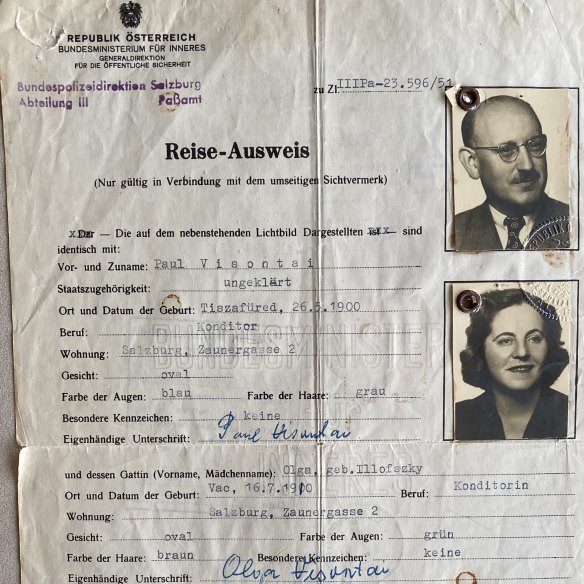
Austrian travel documents for Pali and Olga Visontai, 1951.Credit: Visontay Family
The woman’s name was Olga Illovfsky and she was Gabriel Wells’ niece. Olga’s husband had also died in Auschwitz, she somehow survived by hiding in the woods and the house was all she had left from her life before the war. Over the next year Pali revived the delicatessen and Ivan went back to school. Then Pali dropped a bombshell: he and Olga were going to get married, a common decision by many survivors who wanted to build a better future for their children. The decision stung Ivan but he had little time to get used to it. Within a few years, the Communists came to power and Pali was kicked out of his delicatessen for the second time. The family knew they had no future in Hungary. Ivan left first, over the mountains to Austria, his parents joining him a few months later. They tried to immigrate to America but were rejected and went to Australia instead. In 1952 they arrived in Sydney, ready to start afresh.
This is where the documents in the red strongbox opened a hidden window into the past. As I pieced together the names and dates in those yellowed letters, I unearthed a whole new chapter in my family history. Gabriel Wells died a wealthy man in New York just after the war, but with no wife or children, and his large estate was divided up between his nephews and nieces. Olga received a modest inheritance – US$21,000 – which sounds inconsequential in today’s money but was enough to help Pali and Ivan start a business. Pali was too old to learn new tricks and he fell back onto what he knew: selling continental smallgoods. They found a shop in Kings Cross, on Macleay Street opposite the Rex Hotel, and called it the “Minerva delicatessen”, in homage to the name of the building and the landmark theatre nearby.
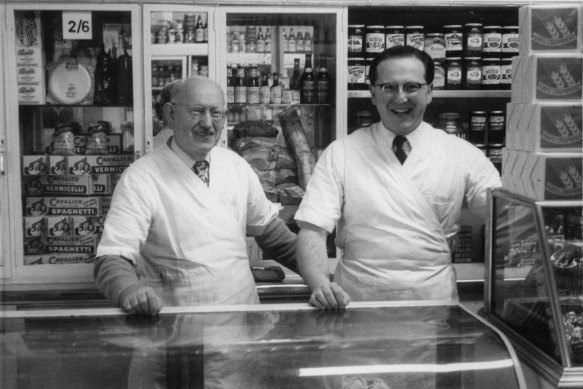
Pali and Ivan Visontay in the Minerva Delicatessen, 1955.Credit: Visontay family
Kings Cross was the ideal location; its maze of small bars and cheap accommodation made it a magnet for post-war European refugees. The air was thick with French, Hungarian, Italian, Greek and Viennese accents, and the smell of their foods. And the Minerva deli stood at the epicentre of the Cross’s bohemian underworld. A few shops down the street, the “Witch of Kings Cross”, Rosaleen Norton, was painting obscene murals on the walls of the Kashmir Café, around the corner Abe Saffron was directing Sydney’s crime world from the swanky Roosevelt nightclub, and up the other end of Macleay Street, ASIO conducted a sting in a fancy apartment block to entrap the Soviet diplomat-spy, Vadimir Petrov.
Sadly, Olga died from a stroke less than a year after they bought the delicatessen, which soon became the beating heart of our family’s life. Every significant relationship started in the shop. Ivan was introduced to my mother Eva, Pali’s teenage sweetheart from Hungary walked in one day and soon became his third wife. The Cross’s colourful street life of artists, crooks, prostitutes and transvestites also opened my eyes to the weird and wonderful world beyond my sheltered suburban upbringing.
On the other side of the counter, Colonel Sanders dropped in to taste the “Mother’s Own” chickens that Ivan dreamed up in response to KFC, and during the heyday of the Vietnam War, a string of famous entertainers would stop in to try piroshki and other delicacies. Ivan worked 12 hours a day, six days a week, laying the foundation for a comfortable childhood for my brother and me. When Gabriel Wells sold off the Noble Fragments, he unleashed a chain of events that underwrote my family’s rebirth.
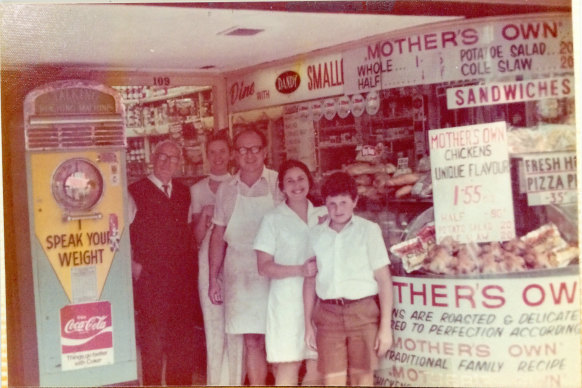
Pali Visontay, a shop assistant, Ivan, Eva, and Michael Visontay, outside MinervaDelicatessen, Potts Point, Sydney, 1971.Credit: Visontay Family
Their dispersal also gave the leaves a new life. No longer mere pages in a book, they became a prize in their own right. I became obsessed by the Gutenberg’s invisible imprint on my family and set out to track down the pages of the broken bible, which propelled me into the arcane world of rare book collectors, dealers and auction houses. I picked the brains of old-world booksellers in London, searched for catalogue secrets at Christie’s, visited the French National Library in Paris and had midnight Zoom conversations with a nonagenarian archivist in a California nursing home.
Their stories ranged from charming to strange. The Vancouver Public Library bought a leaf thanks to a subscription drive by Sunday-school kids. A French wine merchant bought one that features the start of the parable of the vineyard; it later ended up in an Italian library of gastronomic literature. One leaf was subjected to chemical analysis in an American nuclear laboratory; a few years ago a pro-Putin Ukrainian politician announced he had bought a leaf but before scholars could find out more, Russia attacked Ukraine, the politician was arrested and the leaf vanished.
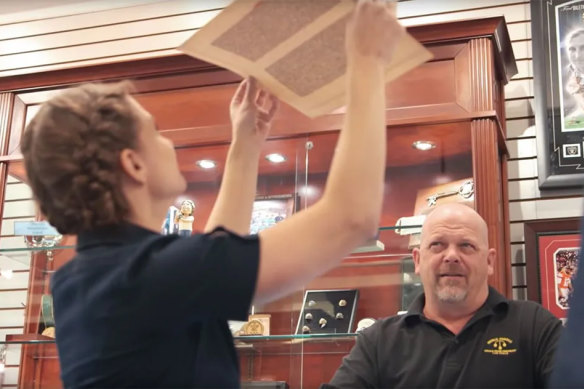
Rare-book authenticator Rebecca Romney inspects a Noble Fragment with Pawn Stars host Rick Harrison looking on, October 2017.Credit: History Channel
The Book of Joshua spent decades in the collection of a German industrialist whose company made ball-bearings for Hitler’s war machine; it was recently bought by a museum in Seoul, where it sits alongside samples of cuneiform and hieroglyphics. One leaf was even traded on an American reality TV show, and a handful have fetched up in Australian universities, public libraries and the collection of Kerry Stokes.
The jury remains divided over whether Gabriel Wells’ venture was, to borrow from Woody Allen, a crime or a misdemeanour. Beyond the intuitive feeling that the whole is greater than the sum of its parts, the dispersal has enabled the leaves to be spread around the globe, passing increasingly over the years from private hands into public institutions. If the Gutenberg democratised knowledge, then Wells democratised the book that democratised knowledge. He took it out of the hands of just a few and passed it into the hands of many.
Today Gabriel Wells is largely forgotten. His business died with him and his reputation has faded. Yet Wells left something of lasting value over here on the other side of the world, far away from the wood-pannelled walls of New York clubs: a delicatessen in Kings Cross. Seventy years on, my parents are no longer with us, but the shop is still there, albeit trading these days as an upmarket homeware business. It feels like a birthright that is impossible to shrug off. The Noble Fragments are now imbued with the DNA of my family’s odyssey. One man’s decision to break up a Gutenberg bible has rippled through the decades and across the oceans, and set me on a path of endless reward.
Michael Visontay’s Noble Fragments: The maverick who broke up the world’s greatest book (Scribe $36.99) is out on October 29.
The Booklist is a weekly newsletter for book lovers from books editor Jason Steger. Get it delivered every Friday.


